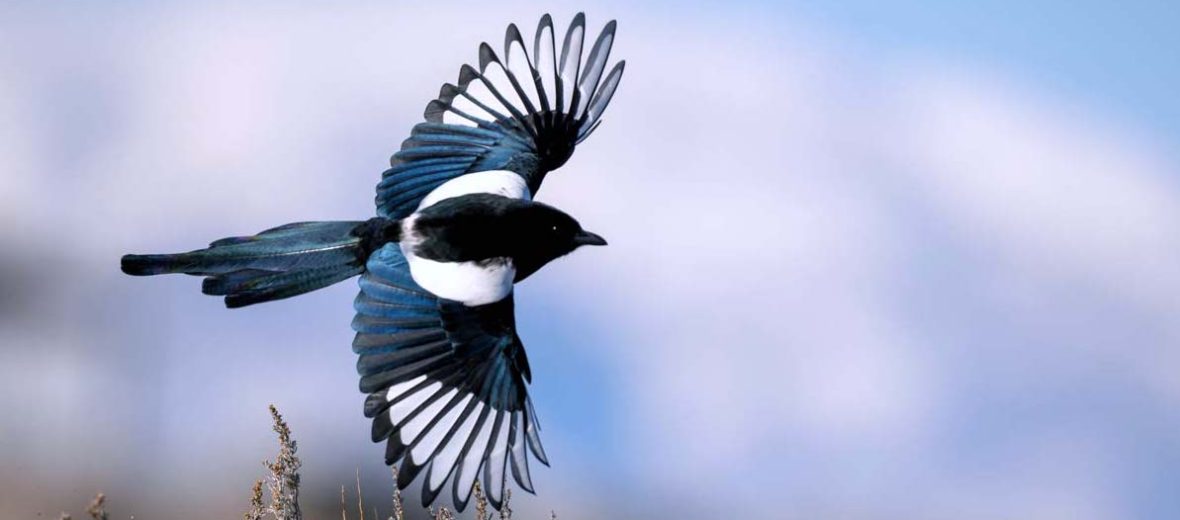
The black-billed magpie, aka American magpie, can be found from western Alaska, down through the western half of Canada, on into the western half of the United States. They prefer farmlands, grasslands, shrublands, rocky habitats, suburban, and urban locales (that provide gatherings of trees). Due to their stable numbers and wide distribution, these birds are listed as Least Concern by the IUCN. Their numbers are estimated at around 5.4 million wild individuals.
First the Stats…
Scientific name: Pica hudsonia
Weight: Up to 7.6 ounces
Length: Up to 24 inches
Wingspan: Up to 17.2 inches
Lifespan: Up to 6 years
Now on to the Facts!
1.) These social birds live in groups of up to 10 individuals.
2.) During the cold winter months, they gather into larger communal tidings.
3.) A group of magpies is called a charm, congregation, gulp, parliament, or tiding.
4.) When sleeping, they will tuck their head into their wing and back feathers.
5.) At night, they have the tendency to regurgitate pellets from the undigested parts of the foods they eat.
But wait, there’s more on the black-billed magpie!
6.) Black-billed magpies typically look for food while walking or hopping along the ground.
7.) Their calls vary, but are usually a scratchy, rough sounding call. When threatened, they will emit a piercing scream.
Did you know…?
If mapgies happen upon a dead mapgie, they will often let out a call that gathers other magpies near in what is referred to as a funeral.
8.) Insects, carrion (dead animals), seeds, mice, baby rats, eggs, nuts, and berries make up the bulk of their diet. However, they happily take garbage and unguarded food left from feeding pets outside.
9.) The black-billed magpie is monogamous (mates for life).
10.) Breeding season lasts from March to the beginning of July.
But wait, there’s still more on the black-billed magpie!
11.) Both the male and female construct their nest each season out of branches, grass, twigs, mud, roots, strips of bark, vines, needles, and more. The inner lining of the nest, sometimes called the cup, is lined with grass, and other soft items; like feathers.
12.) Nests nearly always have a dome or roof to help keep out the elements. The nest also has multiple side entrances.
13.) Females lay up to 13 eggs – with 7 being the norm – that hatch in up to 21 days.
Did you know…?
Magpies only fly an average of up to 20 mph. Preferring to walk and hop, rather than flying.
14.) Chicks are fed almost entirely on animal matter.
15.) Only the female incubates the eggs, but the male will bring mom food, throughout the process.
But wait, there’s still a little more on the black-billed magpie!
16.) Like most birds, the young are born altricial (blind and helpless).
17.) The female will brood the young, but both parents participate in feeding their brood.
18.) Chicks are flying in up to 4 weeks and then spend another 2 months with mom and dad, until leaving to join other young mapgies.
Did you know…?
Contrary to popular belief and folklore, magpies do not steal and collect shiny objects. They are actually quite scared of shiny objects, and tend to avoid them.
19.) A threat to their survival is the use of topical pesticides, by ranchers, that aid in preventing ticks on cattle. Magpies have been known to land on the backs of cattle and pick off ticks. The birds ingest the topical poison and die.
20.) Wolf packs are sometimes followed as the wolf’s kill, when abandoned, provides food for the magpies.
21.) Golden eagles, hawks, and raccoons prey on the young and steal eggs, when they can.
Now a Short Black-Billed Magpie Video!
Be sure to share & comment below! Also, check out the Critter Science YouTube channel.
Want to suggest a critter for me to write about? Let me know here.



